Navigant Issues New DRMS ReportThursday, September 1, 2016 Demand Response Management SystemsInvestor-Owned, Municipal, Federal, and Cooperative Utility, Distribution System Operator, and Retailer DR Programs: Global Market Analysis and ForecastsLearn more at https://www.navigantresearch.com/research/demand-response-management-systems Demand response (DR) is an older concept that was first employed in the United States during the 1970s. As the scale and complexity of DR programs has increased over the last decade, their operational reliability has become more critical and the choices of communications protocols and devices have expanded. There is a need for more centralized management and control, similar to what is done on the power generation side of the electricity market. Numerous vendors have come from many different areas in the industry to offer solutions categorized as demand response management systems (DRMSs). DR plays an important role in the landscape of low carbon policies and regulations, the changing resources mix, and evolving utility business models. Utilities deploy DRMSs to manage their portfolios of DR programs, address existing compliance and financial risks, and increase customer satisfaction. Drivers range from optimized DR management, customer cost reduction, improved system stability, integration of distributed energy resources (DER), and competitive retail suppliers entering the market. Yet, vendors note that the uptake of DRMSs has been slow. The key barriers to the adoption of DRMS are the high cost of the system and the complexity associated with it. According to Navigant Research, global DRMS spending is expected to grow from $46.1 million in 2016 to $232.3 million in 2025. This Navigant Research report analyzes the DRMS market, covering residential, commercial and industrial, on-premise, and software as a service (SaaS) solutions. The study provides an analysis of the market issues, including drivers and implementation barriers, associated with DRMSs. Global market forecasts, segmented by region and sector (investor-owned utilities, municipal utilities, federal utilities, electric cooperatives, distribution system operators, and retailers), extend through 2025. The report also examines the key technologies related to DRMSs, as well as relevant case studies and the competitive landscape. Key Questions Addressed:
Who needs this report?
Table of Contents1. Executive Summary 1.1 Introduction to Demand Response Management Systems 1.2 Market Drivers 1.3 Market Barriers 1.4 Technology 1.5 Market Forecast 2. Market Issues 2.1 History and Evolutionary Path of Demand Response Management Systems 2.2 Definition of the DRMS 2.3 Drivers for DRMSs 2.3.1 DR Program Management 2.3.2 Cost Reductions 2.3.3 DER Integration 2.3.4 Integration with Other Systems 2.3.5 Grid Modernization 2.3.6 Distribution Grid Operators 2.3.7 Competitive Retailer Energy Suppliers 2.4 Barriers to DRMS Implementation 2.4.1 DRMS Costs 2.4.2 Integration Complexity 2.4.3 Flexibility and Interoperability Limitations 2.5 Case Studies 2.5.1 NV Energy 2.5.2 CPS Energy 2.5.3 Direct Energy 3. Technology Issues 3.1 General Overview 3.2 DRMS Functionality 3.2.1 DR Devices 3.2.2 Pricing Programs 3.2.3 Customer Portals 3.2.4 Utility Portals 3.2.5 Aggregation 3.2.6 Forecasting 3.2.7 M&V 3.3 Full-Scale versus Sector-Specific DRMSs 3.4 User Types 3.4.1 DRMSs for Wholesale Markets 3.5 On-Premise Solutions versus SaaS 3.6 Communications Protocols 3.6.1 OpenADR 3.6.1.1 OpenADR 2.0 3.6.2 MultiSpeak 3.7 Future of DRMSs 3.7.1 ADMS 3.7.2 DERMSs 3.7.3 Customer Engagement 4. Key Industry Players 4.1 Competitive Overview 4.1.1 Standalone DRMS Vendors 4.1.1.1 ABB 4.1.1.2 AutoGrid 4.1.1.3 Comverge 4.1.1.4 GE 4.1.1.5 Honeywell 4.1.1.6 Lockheed Martin 4.1.1.7 Nexant 4.1.1.8 Open Access Technology International 4.1.1.9 Siemens 4.1.2 Residential-Focused DRMS Vendors 4.1.2.1 Eaton 4.1.2.2 EnergyHub 4.1.2.3 Landis+Gyr 4.1.3 C&I-Focused DRMS Vendors 4.1.3.1 CPower 4.1.3.2 Enbala 4.1.3.3 EnerNOC 4.1.3.4 Schneider Electric 5. Market Forecasts 5.1 Forecast Introduction 5.2 Assumptions Guiding this Forecast 5.3 Global DRMS Adoption 5.4 Global DRMS Spending 5.5 Conclusions and Recommendations 6. Acronym and Abbreviation List 7. Table of Contents 8. Table of Charts and Figures 9. Scope of Study, Sources and Methodology, Notes |
